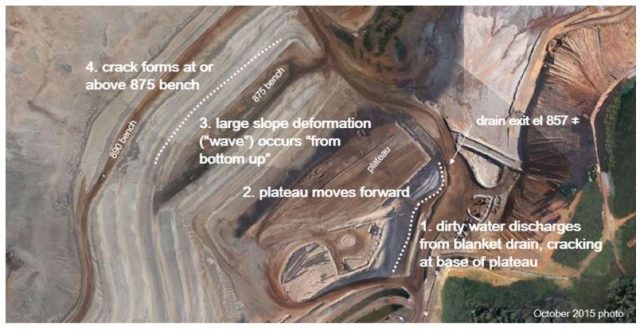30 August 2016
The official report into the Samarco Tailings Dam failure in Brazil
Posted by Dave Petley
The official report into the Samarco Tailings Dam failure in Brazil
Yesterday the official report into the Samarco Tailings Dam failure and associated flowslide last year in Brazil was released. Impressively, a website has been set up to provide access to the report – there is a simple registration process after which the full report is freely available. This is a full and comprehensive investigation that needs detailed explanation, undertaken by a highly credible panel. I will give only the highlights here.
The report finds that the failure initiated in the left abutment of the dam as a result of groundwater pressures in an area of the dam that “was underlain by slimes”. In other words, this portion of the dam was constructed on mining waste. The mechanism of failure is well-known – so called lateral extrusion – which occurs when soft sands overlie soft mining waste. The latter then spreads laterally, deforming the overlying sands.
The report provides a nice illustration of the failure sequence:

\Illustration of the failure sequence of the Samarco tailings dam, from the official report
.
The question of course is then how the site of the Samarco Tailings Dam failure ended up in this vulnerable state. The report is quite clear on this, and the analysis is not going to be comfortable reading for the operators:
Why Did a Flowslide Occur?
The original design concept for the Fundão Dam employed an unsaturated sand zone to support the weak slimes zone. Unsaturated sand is not amenable to liquefaction and hence the original design was robust in this regard. However, difficulties were encountered in executing the design and a modified design was put forward and adopted. As part of this modification, a change in the design concept was also adopted and saturated conditions were permitted to develop in the sand.
The report documents a series of significant events leading up to the failure. In 2009 a major seepage event occurred in the dam:
The first incident occurred in 2009 shortly after the Starter Dam was completed. Due to construction defects in the base drain, the dam was so badly damaged that the original concept could no longer be implemented. Instead, a revised design substituted a new drainage blanket at a higher elevation.
Then in 2011 and 2012 problems arose with management of the mining waste and water:
The second incident associated with slimes and water management occurred over an extended period of time in 2011 and 2012 while the new design was being constructed. During operation, the 200 m beach width criterion was often not met, with water encroaching to as little as 60 m from the crest. This allowed slimes to settle out in areas where they were not intended to exist.
In 2012 problems arose with structural problems in a concrete conduit under the dam, which required that dam alignment was set back, and the constructed over mine tailings. This can be seen in the diagram above – the setback created the plateau that is highlighted in item 2. Problems developed through 2013 and 2014 as seepage was repeatedly observed, and in 2014 extensive cracking was observed in the left abutment setback.
All of this left the dam in what is described as a “precarious state of stability”. Final failure might have been triggered by three small seismic shocks about 90 minutes before the collapse.
I will blog about the detailed mechanism in the next few days.


 Dave Petley is the Vice-Chancellor of the University of Hull in the United Kingdom. His blog provides commentary and analysis of landslide events occurring worldwide, including the landslides themselves, latest research, and conferences and meetings.
Dave Petley is the Vice-Chancellor of the University of Hull in the United Kingdom. His blog provides commentary and analysis of landslide events occurring worldwide, including the landslides themselves, latest research, and conferences and meetings.
Apparently, there’s not much being said about the persecution of the usual suspects, who are responsible for this tragedy. Neither we see on the news, the current conditions of the area of the river hit by the mineral residues of the dam. Is it a cover up?